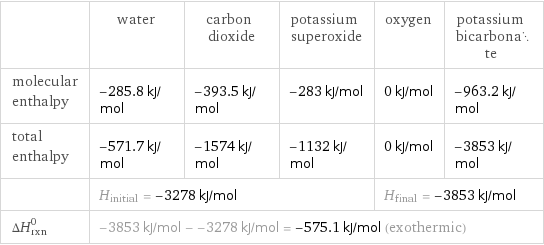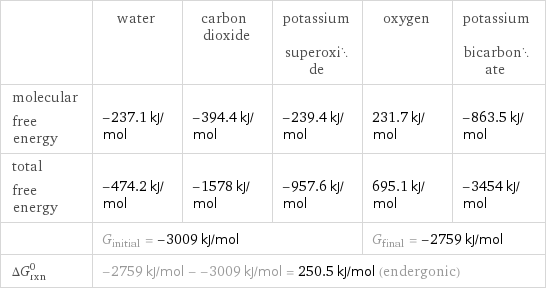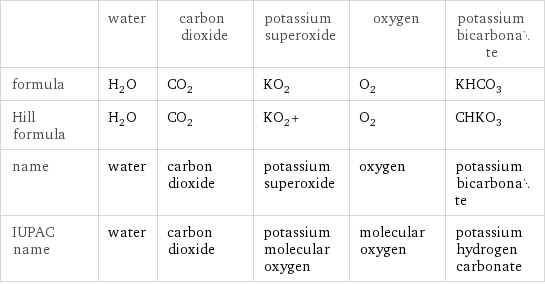Input interpretation

H_2O water + CO_2 carbon dioxide + KO_2 potassium superoxide ⟶ O_2 oxygen + KHCO_3 potassium bicarbonate
Balanced equation

Balance the chemical equation algebraically: H_2O + CO_2 + KO_2 ⟶ O_2 + KHCO_3 Add stoichiometric coefficients, c_i, to the reactants and products: c_1 H_2O + c_2 CO_2 + c_3 KO_2 ⟶ c_4 O_2 + c_5 KHCO_3 Set the number of atoms in the reactants equal to the number of atoms in the products for H, O, C and K: H: | 2 c_1 = c_5 O: | c_1 + 2 c_2 + 2 c_3 = 2 c_4 + 3 c_5 C: | c_2 = c_5 K: | c_3 = c_5 Since the coefficients are relative quantities and underdetermined, choose a coefficient to set arbitrarily. To keep the coefficients small, the arbitrary value is ordinarily one. For instance, set c_1 = 1 and solve the system of equations for the remaining coefficients: c_1 = 1 c_2 = 2 c_3 = 2 c_4 = 3/2 c_5 = 2 Multiply by the least common denominator, 2, to eliminate fractional coefficients: c_1 = 2 c_2 = 4 c_3 = 4 c_4 = 3 c_5 = 4 Substitute the coefficients into the chemical reaction to obtain the balanced equation: Answer: | | 2 H_2O + 4 CO_2 + 4 KO_2 ⟶ 3 O_2 + 4 KHCO_3
Structures

+ + ⟶ +
Names

water + carbon dioxide + potassium superoxide ⟶ oxygen + potassium bicarbonate
Reaction thermodynamics
Enthalpy

| water | carbon dioxide | potassium superoxide | oxygen | potassium bicarbonate molecular enthalpy | -285.8 kJ/mol | -393.5 kJ/mol | -283 kJ/mol | 0 kJ/mol | -963.2 kJ/mol total enthalpy | -571.7 kJ/mol | -1574 kJ/mol | -1132 kJ/mol | 0 kJ/mol | -3853 kJ/mol | H_initial = -3278 kJ/mol | | | H_final = -3853 kJ/mol | ΔH_rxn^0 | -3853 kJ/mol - -3278 kJ/mol = -575.1 kJ/mol (exothermic) | | | |
Gibbs free energy

| water | carbon dioxide | potassium superoxide | oxygen | potassium bicarbonate molecular free energy | -237.1 kJ/mol | -394.4 kJ/mol | -239.4 kJ/mol | 231.7 kJ/mol | -863.5 kJ/mol total free energy | -474.2 kJ/mol | -1578 kJ/mol | -957.6 kJ/mol | 695.1 kJ/mol | -3454 kJ/mol | G_initial = -3009 kJ/mol | | | G_final = -2759 kJ/mol | ΔG_rxn^0 | -2759 kJ/mol - -3009 kJ/mol = 250.5 kJ/mol (endergonic) | | | |
Equilibrium constant
![Construct the equilibrium constant, K, expression for: H_2O + CO_2 + KO_2 ⟶ O_2 + KHCO_3 Plan: • Balance the chemical equation. • Determine the stoichiometric numbers. • Assemble the activity expression for each chemical species. • Use the activity expressions to build the equilibrium constant expression. Write the balanced chemical equation: 2 H_2O + 4 CO_2 + 4 KO_2 ⟶ 3 O_2 + 4 KHCO_3 Assign stoichiometric numbers, ν_i, using the stoichiometric coefficients, c_i, from the balanced chemical equation in the following manner: ν_i = -c_i for reactants and ν_i = c_i for products: chemical species | c_i | ν_i H_2O | 2 | -2 CO_2 | 4 | -4 KO_2 | 4 | -4 O_2 | 3 | 3 KHCO_3 | 4 | 4 Assemble the activity expressions accounting for the state of matter and ν_i: chemical species | c_i | ν_i | activity expression H_2O | 2 | -2 | ([H2O])^(-2) CO_2 | 4 | -4 | ([CO2])^(-4) KO_2 | 4 | -4 | ([KO2])^(-4) O_2 | 3 | 3 | ([O2])^3 KHCO_3 | 4 | 4 | ([KHCO3])^4 The equilibrium constant symbol in the concentration basis is: K_c Mulitply the activity expressions to arrive at the K_c expression: Answer: | | K_c = ([H2O])^(-2) ([CO2])^(-4) ([KO2])^(-4) ([O2])^3 ([KHCO3])^4 = (([O2])^3 ([KHCO3])^4)/(([H2O])^2 ([CO2])^4 ([KO2])^4)](../image_source/0705d3daeb0ffe181f3efc768c74f593.png)
Construct the equilibrium constant, K, expression for: H_2O + CO_2 + KO_2 ⟶ O_2 + KHCO_3 Plan: • Balance the chemical equation. • Determine the stoichiometric numbers. • Assemble the activity expression for each chemical species. • Use the activity expressions to build the equilibrium constant expression. Write the balanced chemical equation: 2 H_2O + 4 CO_2 + 4 KO_2 ⟶ 3 O_2 + 4 KHCO_3 Assign stoichiometric numbers, ν_i, using the stoichiometric coefficients, c_i, from the balanced chemical equation in the following manner: ν_i = -c_i for reactants and ν_i = c_i for products: chemical species | c_i | ν_i H_2O | 2 | -2 CO_2 | 4 | -4 KO_2 | 4 | -4 O_2 | 3 | 3 KHCO_3 | 4 | 4 Assemble the activity expressions accounting for the state of matter and ν_i: chemical species | c_i | ν_i | activity expression H_2O | 2 | -2 | ([H2O])^(-2) CO_2 | 4 | -4 | ([CO2])^(-4) KO_2 | 4 | -4 | ([KO2])^(-4) O_2 | 3 | 3 | ([O2])^3 KHCO_3 | 4 | 4 | ([KHCO3])^4 The equilibrium constant symbol in the concentration basis is: K_c Mulitply the activity expressions to arrive at the K_c expression: Answer: | | K_c = ([H2O])^(-2) ([CO2])^(-4) ([KO2])^(-4) ([O2])^3 ([KHCO3])^4 = (([O2])^3 ([KHCO3])^4)/(([H2O])^2 ([CO2])^4 ([KO2])^4)
Rate of reaction
![Construct the rate of reaction expression for: H_2O + CO_2 + KO_2 ⟶ O_2 + KHCO_3 Plan: • Balance the chemical equation. • Determine the stoichiometric numbers. • Assemble the rate term for each chemical species. • Write the rate of reaction expression. Write the balanced chemical equation: 2 H_2O + 4 CO_2 + 4 KO_2 ⟶ 3 O_2 + 4 KHCO_3 Assign stoichiometric numbers, ν_i, using the stoichiometric coefficients, c_i, from the balanced chemical equation in the following manner: ν_i = -c_i for reactants and ν_i = c_i for products: chemical species | c_i | ν_i H_2O | 2 | -2 CO_2 | 4 | -4 KO_2 | 4 | -4 O_2 | 3 | 3 KHCO_3 | 4 | 4 The rate term for each chemical species, B_i, is 1/ν_i(Δ[B_i])/(Δt) where [B_i] is the amount concentration and t is time: chemical species | c_i | ν_i | rate term H_2O | 2 | -2 | -1/2 (Δ[H2O])/(Δt) CO_2 | 4 | -4 | -1/4 (Δ[CO2])/(Δt) KO_2 | 4 | -4 | -1/4 (Δ[KO2])/(Δt) O_2 | 3 | 3 | 1/3 (Δ[O2])/(Δt) KHCO_3 | 4 | 4 | 1/4 (Δ[KHCO3])/(Δt) (for infinitesimal rate of change, replace Δ with d) Set the rate terms equal to each other to arrive at the rate expression: Answer: | | rate = -1/2 (Δ[H2O])/(Δt) = -1/4 (Δ[CO2])/(Δt) = -1/4 (Δ[KO2])/(Δt) = 1/3 (Δ[O2])/(Δt) = 1/4 (Δ[KHCO3])/(Δt) (assuming constant volume and no accumulation of intermediates or side products)](../image_source/0e63f7749678ecab3023c4b2db406868.png)
Construct the rate of reaction expression for: H_2O + CO_2 + KO_2 ⟶ O_2 + KHCO_3 Plan: • Balance the chemical equation. • Determine the stoichiometric numbers. • Assemble the rate term for each chemical species. • Write the rate of reaction expression. Write the balanced chemical equation: 2 H_2O + 4 CO_2 + 4 KO_2 ⟶ 3 O_2 + 4 KHCO_3 Assign stoichiometric numbers, ν_i, using the stoichiometric coefficients, c_i, from the balanced chemical equation in the following manner: ν_i = -c_i for reactants and ν_i = c_i for products: chemical species | c_i | ν_i H_2O | 2 | -2 CO_2 | 4 | -4 KO_2 | 4 | -4 O_2 | 3 | 3 KHCO_3 | 4 | 4 The rate term for each chemical species, B_i, is 1/ν_i(Δ[B_i])/(Δt) where [B_i] is the amount concentration and t is time: chemical species | c_i | ν_i | rate term H_2O | 2 | -2 | -1/2 (Δ[H2O])/(Δt) CO_2 | 4 | -4 | -1/4 (Δ[CO2])/(Δt) KO_2 | 4 | -4 | -1/4 (Δ[KO2])/(Δt) O_2 | 3 | 3 | 1/3 (Δ[O2])/(Δt) KHCO_3 | 4 | 4 | 1/4 (Δ[KHCO3])/(Δt) (for infinitesimal rate of change, replace Δ with d) Set the rate terms equal to each other to arrive at the rate expression: Answer: | | rate = -1/2 (Δ[H2O])/(Δt) = -1/4 (Δ[CO2])/(Δt) = -1/4 (Δ[KO2])/(Δt) = 1/3 (Δ[O2])/(Δt) = 1/4 (Δ[KHCO3])/(Δt) (assuming constant volume and no accumulation of intermediates or side products)
Chemical names and formulas

| water | carbon dioxide | potassium superoxide | oxygen | potassium bicarbonate formula | H_2O | CO_2 | KO_2 | O_2 | KHCO_3 Hill formula | H_2O | CO_2 | KO_2+ | O_2 | CHKO_3 name | water | carbon dioxide | potassium superoxide | oxygen | potassium bicarbonate IUPAC name | water | carbon dioxide | potassium molecular oxygen | molecular oxygen | potassium hydrogen carbonate